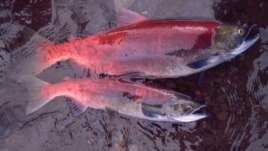26 August 2020
Alaska's salmon - popular among seafood lovers around the world - are getting smaller. Their change in size might be a result of climate change and increased competition, a recent study said.
The study, led by University of Alaska at Fairbanks (UAF) scientists, found that four of Alaska's five wild salmon species have shrunk in average size over the past sixty years.
Alaska's official state fish, the Chinook salmon - also known as king salmon – have decreased the most in size. Chinooks are 8 percent smaller, on average, than they were before 1990.

One additional year in the ocean makes a big difference in the size of salmon, as seen in these two female sockeye salmon from Pick Creek, Alaska. (Andrew Hendry/Handout via REUTERS)
The study, which appeared recently in the journal Nature Communications, also said Alaska's sockeye, coho and chum salmon are shrinking. The findings are based on data from 12.5 million samples collected over six decades.
Peter Westley of UAF's College of Fisheries and Ocean Sciences co-wrote the study. It confirms some stories told by Alaskans who have lived in the state for many years, Westley said. "People are walking into their smokehouses and not having to duck anymore...The fish are just smaller."
A smokehouse is a building in which meat is cured with smoke.
The likeliest reasons for the fish shrinkage, Westley explained, are warmer seas resulting from climate change and increased competition among all species of salmon.
Salmon are maturing in the ocean at earlier ages, the study found. The salmon return to fresh water at younger ages and smaller sizes than they did in the past.
In some of Alaska's rivers, the really big fish that spend seven or eight years in the ocean are no longer seen, Westley said.
Alaska produces nearly all of America's wild salmon. Last year, fishermen harvested over 206 million salmon and sold them for $657.6 million, state officials reported. Salmon are also an important food for indigenous people of Alaska and Canada's Yukon Territory.
The reddish fish are also eaten by Alaska's bears and other animals in the wild. Smaller fish mean fewer salmon eggs - and fewer calories for those animals. That could have long-term effects on the salmon population and the animals that feed on them, said UAF's Krista Oke, the study's lead author.
The findings show the need to manage salmon not just for the size of their runs but for the size of individual fish, Westley said. "If you lose the diversity of fish and only have small fish, then you're in troubled waters," he said.
I'm John Russell.
Yereth Rosen reported on this story for Reuters.John Russell adapted it for Learning English. Hai Do was the editor.
_____________________________________________________________
Words in This Story
species– n. biology : a group of animals or plants that are similar and can produce young animals or plants : a group of related animals or plants that is smaller than a genus
journal – n. a magazine that reports on things of special interest to a particular group of people
mature – v. to become mature: such as to become fully developed in the body and mind
indigenous – adj. produced, living, or existing naturally in a particular region or environment (indigenous people are ethnic groups who are the earliest known people in an area)
manage – v. to control the movements or actions of (something); to use (something) carefully and without waste